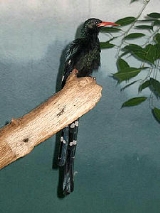
Phoeniculus
Encyclopedia
Phoeniculus is a genus of bird
in the Phoeniculidae family. They are restricted to sub-Saharan Africa
.
The genus contains the following species:
Members of this genus have long, slightly down-curved, pointed bills with stout bases. Most spend the day in flocks of 5 to 12 birds, acrobatically climbing in trees or hanging underneath branches, sticking their bills into crevices in search of insects and other small arthropods. They may brace themselves with their long tails as woodpecker
s do, but the tail feathers are not stiff like woodpeckers' and wear easily. Though their feet are strong, their floppy and bounding flight is weak and not sustained long. They are noisy and may take breaks from foraging to engage in a "rally": they "cackle" or "chuckle" together and rock back and forth, the wings half opened, the tail oscillating up and down. This ceremony helps keep the group together.
The groups consist largely of parents, helpers, and young. Helpers
are birds that, instead of breeding, help another pair defend the nest and feed the young. This practice improves reproductive success. The helpers may breed the following year; as a result of the bonds they formed with the young they helped, the latter may become their helpers in turn.
Bird
Birds are feathered, winged, bipedal, endothermic , egg-laying, vertebrate animals. Around 10,000 living species and 188 families makes them the most speciose class of tetrapod vertebrates. They inhabit ecosystems across the globe, from the Arctic to the Antarctic. Extant birds range in size from...
in the Phoeniculidae family. They are restricted to sub-Saharan Africa
Sub-Saharan Africa
Sub-Saharan Africa as a geographical term refers to the area of the African continent which lies south of the Sahara. A political definition of Sub-Saharan Africa, instead, covers all African countries which are fully or partially located south of the Sahara...
.
The genus contains the following species:
- White-headed Wood Hoopoe (Phoeniculus bollei)
- Forest Wood Hoopoe (Phoeniculus castaneiceps)
- Violet Wood Hoopoe (Phoeniculus damarensis)
- Black-billed Wood Hoopoe (Phoeniculus somaliensis)
- Green Wood HoopoeGreen Wood HoopoeThe Green Wood Hoopoe is a large, up to 44 cm long, near-passerine tropical bird native to Africa. It is a member of the family Phoeniculidae, the wood hoopoes, and is formally known as the Red-billed Wood Hoopoe....
(Phoeniculus purpureus)
Members of this genus have long, slightly down-curved, pointed bills with stout bases. Most spend the day in flocks of 5 to 12 birds, acrobatically climbing in trees or hanging underneath branches, sticking their bills into crevices in search of insects and other small arthropods. They may brace themselves with their long tails as woodpecker
Woodpecker
Woodpeckers are near passerine birds of the order Piciformes. They are one subfamily in the family Picidae, which also includes the piculets and wrynecks. They are found worldwide and include about 180 species....
s do, but the tail feathers are not stiff like woodpeckers' and wear easily. Though their feet are strong, their floppy and bounding flight is weak and not sustained long. They are noisy and may take breaks from foraging to engage in a "rally": they "cackle" or "chuckle" together and rock back and forth, the wings half opened, the tail oscillating up and down. This ceremony helps keep the group together.
The groups consist largely of parents, helpers, and young. Helpers
Helpers at the nest
Helpers at the nest is a term used in behavioural ecology and evolutionary biology to describe a social structure in which juveniles and sexually mature adolescents of either one or both sexes, remain in association with their parents and help them raise subsequent broods or litters, instead of...
are birds that, instead of breeding, help another pair defend the nest and feed the young. This practice improves reproductive success. The helpers may breed the following year; as a result of the bonds they formed with the young they helped, the latter may become their helpers in turn.

